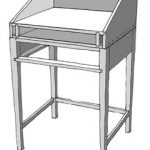We may receive a commission when you use our affiliate links. However, this does not impact our recommendations.

I wrote to you about the English Method because I want you to try it. But I wouldn’t go plugging the hold fast holes in your bench top just quite yet.
All of the images of 18th and early 19th c “English benches” are associated of joiners’ shops. And if you believe as I do, that tools were optimized for a narrow set of materials, work conditions, economic conditions, and techniques, then its safe to assume the English Method and the Nicholson Benches it was used on, do not reflect a universal superiority.
I’ve never seen the mechanicks in Wmsburg stick long sections of molding. I’ve seen small sections held in the (really lame) face vise. That said, a batten applied to the front face of the of Nicholson bench (with the face vise removed) makes an awesome full length sticking board. Of course, if you had some strategically placed holdfasts holes in the top, you could do the same thing, possibly without removing the vise.
I stick moldings against scrap wood held to my top with holdfasts. Maybe this is the French Method, as French benches have tops drilled for holdfasts. I have abandoned my tail vise for planing. I still use its jaws for various, often tool related, projects. But I could easily live without it. I think tail vises are over rated.
What I like about the English method is that it challenges our notion that wood must be jigged in place to be operated on. You really get a lot of feedback from your plane, your iron, and your stock when working this way. The experience is like the difference between turning on a treadle or spring pole lathe, and turning on an electric lathe. The other thing I like about the English Method is that it facillitates work on a simple, easy to build, inexpensive bench. It represents skill over “silver bullet” tools.
One more thing: Popular Woodworking magazine is once again, way out in front on this issue. See Chris’ blog on this issue.
Realizing I just write here, I’d like to say that I’ve encountered people who’ve been working wood for a while and thinkeverything’s been said, and every subject’s been covered already. I think these are peope who haven’t read Popular Woodworking and don’t know who Chris Schwarz is. Friends, there’s more to learn. We’ve only scratched the surface. Try the English Method and see what you think. Let’s explore together.
P.S. I’m wondering if those English joiners didn’t nail their stock to their benches.
Here are some supplies and tools we find essential in our everyday work around the shop. We may receive a commission from sales referred by our links; however, we have carefully selected these products for their usefulness and quality.








Adam
I use the "English method" a lot – Rob Cosman is a big fan of this, and he says it is great for feedback you get and the control that you learn. I would have to agree (although for rough stock prep I prefer to dog the piece down for heavy duty planing)
Keep pushing that envelope – there are those who say everything has been said. But they forget that most of it has then been forgotten!
Cheers
Phil